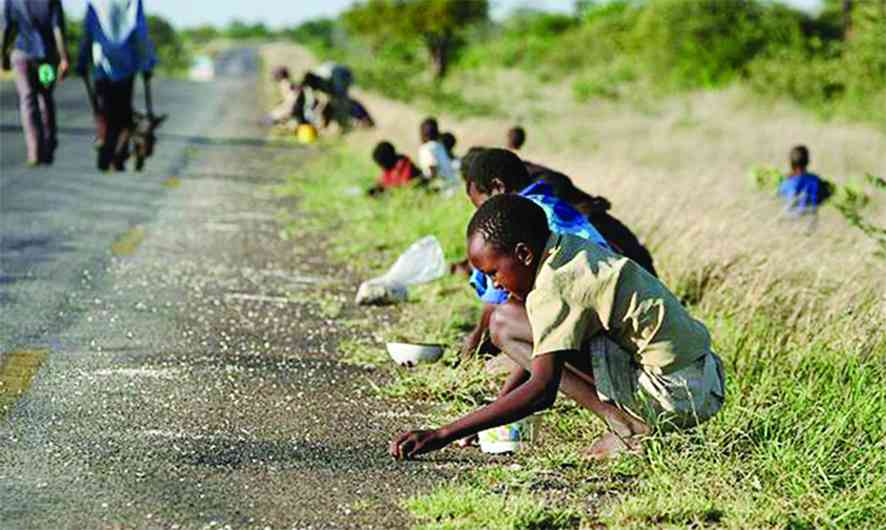
Zimbabwe’s struggle to feed its population has reached alarming proportions, with recent reports indicating that nearly 10 million Zimbabweans are at risk of hunger. This figure, which has seen a stark increase from 7,7 million paints a grim picture of the country's nutritional landscape.
In response to this dire situation, the Zimbabwean government has unveiled a food assistance programme aimed at providing relief to over six million food-insecure citizens. Information minister Jenfan Muswere, speaking during the weekly post-Cabinet briefing last week outlined the details of this initiative.
According to Muswere, "The food insecure people will receive 7,5kg per person per month for the period July to September 2024 and 8,5kg per person per month from October 2024 to March 2025."
This announcement comes hard on the heels of the 2024 Rural Livelihoods Assessment, which determined that a staggering 448 350 metric tonnes of cereal will be required from the National Strategic Grain Reserve between July 2024 and March 2025 to meet the population's basic nutritional needs.
While the government's recognition of the crisis and its efforts to provide immediate relief are commendable, the scale and long-term sustainability of this response raise significant concerns.
The allocation of 7,5 to 8,5 kilogrammes of maize meal per person per month, while providing some respite, may fall short of meeting the comprehensive nutritional requirements of individuals, particularly vulnerable groups such as children, pregnant women and the elderly.
This stopgap measure, while necessary in the short term, underscores the need for more robust and sustainable solutions to addressing the root causes of food insecurity in Zimbabwe.
The current crisis is not merely a result of short-term factors but is deeply intertwined with broader economic challenges, climate-related and governance issues. The El Niño-induced drought has severely impacted harvests, highlighting the vulnerability of Zimbabwe's agricultural sector to climate variability.
- Mavhunga puts DeMbare into Chibuku quarterfinals
- Bulls to charge into Zimbabwe gold stocks
- Ndiraya concerned as goals dry up
- Letters: How solar power is transforming African farms
Keep Reading
This situation calls for a comprehensive approach that goes beyond emergency food distribution to encompass climate-resilient agricultural practices, improved water management and sustainable land use policies.
The Lands, Agriculture, Water and Rural Development ministry faces the daunting task of developing and implementing strategies to enhance agricultural resilience in the face of climate change.
This could involve promoting drought-resistant crop varieties, investing in efficient irrigation systems and providing targeted support to smallholder farmers who form the backbone of Zimbabwe's agricultural sector. In diversifying crop production and adopting conservation agricultural techniques, the country could better withstand future climate shocks and reduce its reliance on emergency food aid.
Concurrently, the Public Service, Labour and Social Welfare ministry must play a pivotal role in coordinating food distribution efforts and ensuring that aid reaches those most in need.
The development of comprehensive social safety nets that extend beyond emergency food aid could provide a more stable foundation for vulnerable households. Cash transfer programmes, for instance, could empower families to meet their needs while stimulating local economies. This necessitates close collaboration with local authorities, non-governmental organisations and community leaders to create a transparent and efficient distribution system. The challenge lies not only in the logistics of food delivery but also in identifying and reaching the most vulnerable populations, including those in remote rural areas.
The government's clarion call for "not leaving anybody behind" is put to the test in the face of this crisis. To truly embody this principle, the response must go beyond the provision of basic food aid to addressing the underlying causes of food insecurity and promotion of inclusive economic development. This includes fostering an environment conducive to job creation, supporting small and medium enterprises in the agricultural sector and investing in rural infrastructure to improve market access for farmers. As Zimbabwe works towards achieving the Sustainable Development Goals (SDGs), particularly SDG 2 (zero hunger) and SDG 13 (climate action), it must adopt a holistic approach that integrates food security efforts with broader development objectives. This includes strengthening the linkages between agriculture, nutrition and health sectors to ensure that food security initiatives contribute to improved overall well-being.
The path forward demands a collective effort from all sectors of society such as the government, civil society, the private sector and international partners. In fostering innovation in agriculture, promoting inclusive economic growth and prioritising sustainable resource management, Zimbabwe can work towards a future where food security is not just an aspiration but a reality for all its citizens. The current crisis, while daunting, presents an opportunity for transformative change that could set the foundation for a more resilient and food-secure Zimbabwe in the years to come.
- Lawrence Makamanzi writes here in his personal capacity and is reachable at his email address blmakamanzi@gmail.com or 0784318605.











